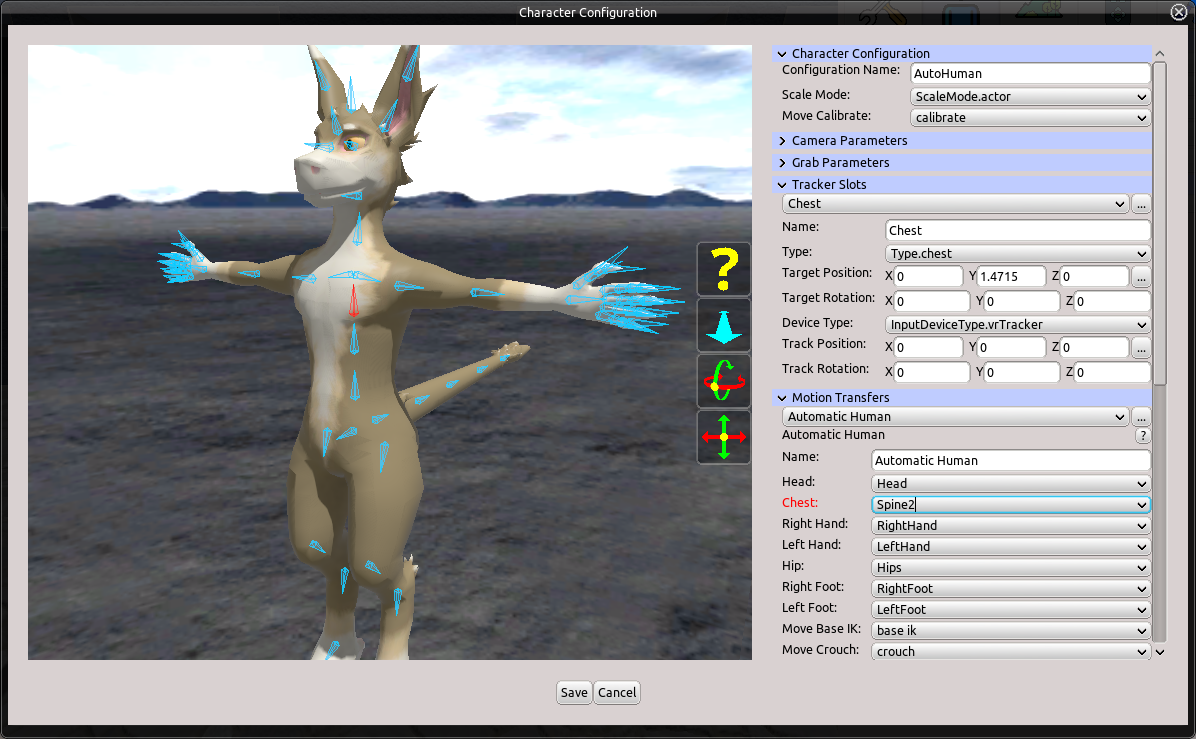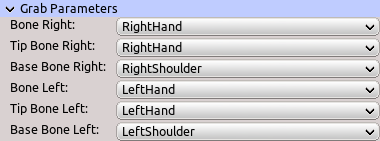This is an old revision of the document!
Table of Contents
Start Page » DEMoCap: Drag[en]gine Motion Capture » Dialog: Character Configuration
This dialog allows to edit character configurations to use as target for the motion capture. Each character has 1 character profile with 1 or more configurations. See the Actor Profile for editing character profiles.
The dialog consists of a 3D preview of the character on the left side and the properties on the right side.
Use the Right Mouse Button to orbit around the character. Use SHIFT and the Right Mouse Button to move the camera sidewards, up and down. Use CONTROL and the Right Mouse Button to zoom in and out. If you are in VR mode you can use the 3 navigation buttons on the right side of the panel to perform the same actions. Point the laser pointer at one of the buttons then pull and hold the trigger to perform the button action (rotate, move, zoom).
Character Configuration
Configuration Name
Unique name of the character configuration. This name is shown in the Character Panel selection box.
Scale Mode
Defines the scale mode to use. This can be either “character” to scale the match the actor or “actor” to scale the actor to match the character. Both have their uses depending on what kind of motion capture you want to perform.
By default “actor” scale mode is used. This scales the actor down to match the size of the character. In this mode the character is kept at the same size as in your game. This is recommended since this way the motion capture data is perfectly fitting without post processing.
If “character” scale is used the character is scaled up to match the size of the actor. This is useful if you want to perform interactions with real world objects. This ensures the animation fits the props used which is not the case if the other scale mode is used.
Move Calibrate
Defines the animation move to use for calibration. Your character is not required to be designed with the calibration pose required by DEMoCap to function properly. Instead you can just create an animation pose where your character is put into an appropriate pose for calibration. See Prepare Character for Motion Capture (Blender3D) for details about how this pose looks like. Once selected the 3D preview shows the character in the calibration pose. You can then set up the tracker slots and motion transfers visually.
Camera Parameters
Defines how the actor sees the virtual world. The virtual camera can be either attached to the character or not attached to the character.
Usually you want to attach the camera to the character head to allow the actor to see the world the way the character would see the world. This way the motion performed by the actor is the most authentic motion. Using VR for motion capture is the only way you can get this kind of authentic motion capture with non-human characters and fantastic game worlds. Attaching camera is used if the attach bone is not an empty string. You can either use a bone specifically designed to represent the camera or you can use the head bone and place the camera in front of the character eyes.
If the attach bone is empty string the camera is not attached. In this mode the camera is placed exactly where the actors head is located. Character/Actor scaling still applies in this mode. Since the camera is now not attached to the character the actor can potentially see the inside of the character depending on how the character is shaped. Not attaching the camera can be useful to capturing tails, wings or additional limbs on top of an already captured body. In this situation the actor would like to see the character from the outside to apply the proper motion.
Bone
Defines the bone to attach the camera to. If no bone is selected (empty string) the camera is not attached and placed where the actor head is located. If the text box is focused the selected bone is highlighted in the 3D view and you can click on a bone to select it.
Position
Defines the position of the camera relative to the attach bone. Has no effect if the attach bone is empty string. If the text box is focused a coordinate system widget is shown in the 3D view. You can click and drag the red, green and blue arrow to move the position along the X (red), Y (green) and Z (blue) axis.
Rotation
Defines the rotation of the camera relative to the attach bone. Has no effect if the attach bone is empty string. If the text box is focused a coordinate system widget is shown in the 3D view. You can click and drag the red, green and blue ring to rotate along the X (red), Y (green) and Z (blue) axis.
Grab Parameters
Defines how the actor can grab objects in the world during motion capture. One of the advantages of using VR for motion capture is that actors can interact with objects to obtain authentic motions. Grabbing is triggered if the actor uses grab motion on his controllers.
Most VR controllers support the concept of grabbing which detects when the user wraps his fingers around the controller grip. Some controllers also support the concept of squeezing which tracks how hard the user squeezes/grabs the controller. DEMoCap uses only the grabbing value returned by VR controllers to trigger grabbing objects. See Grab Attach for information on how you can set up objects for grabbing.
Bone Right/Left
Defines the bone to attach the object to for grabbing with the right/left hand. If no bone is selected (empty string) the object is attached to the controller itself. Typically game characters supporting objects to be attached to their hands have a specific bone set up to attach objects to. If such a bone does not exist you can use the hand bone of your character. If the text box is focused the selected bone is highlighted in the 3D view and you can click on a bone to select it. The relative position and orientation of the object is defined by the Grab Attach properties of the object to be attached.
Tip Bone Right/Left
Defines the tip bone of the temporary inverse kinematics bone chain for the right/left hand. While grabbing an object a temporary inverse kinematics bone chain is used to make the character hands grabbing the object in the right position. The tip bone is the end of the chain near the hands. Typically you use the hand bone here. If this bone is empty no temporary inverse kinematics is used. It is recommended to use temporary inverse kinematics to support situations like grabbing a door handle or objects which are static (like a ladder). If the text box is focused the selected bone is highlighted in the 3D view and you can click on a bone to select it.
Base Bone Right/Left
Defines the base bone of the temporary inverse kinematics bone chain for the right/left hand. The base bone is the end of the chain near the shoulder. Typically you use the upper arm bone or shoulder bone here. If this bone is empty no temporary inverse kinematics is used. If the text box is focused the selected bone is highlighted in the 3D view and you can click on a bone to select it.





